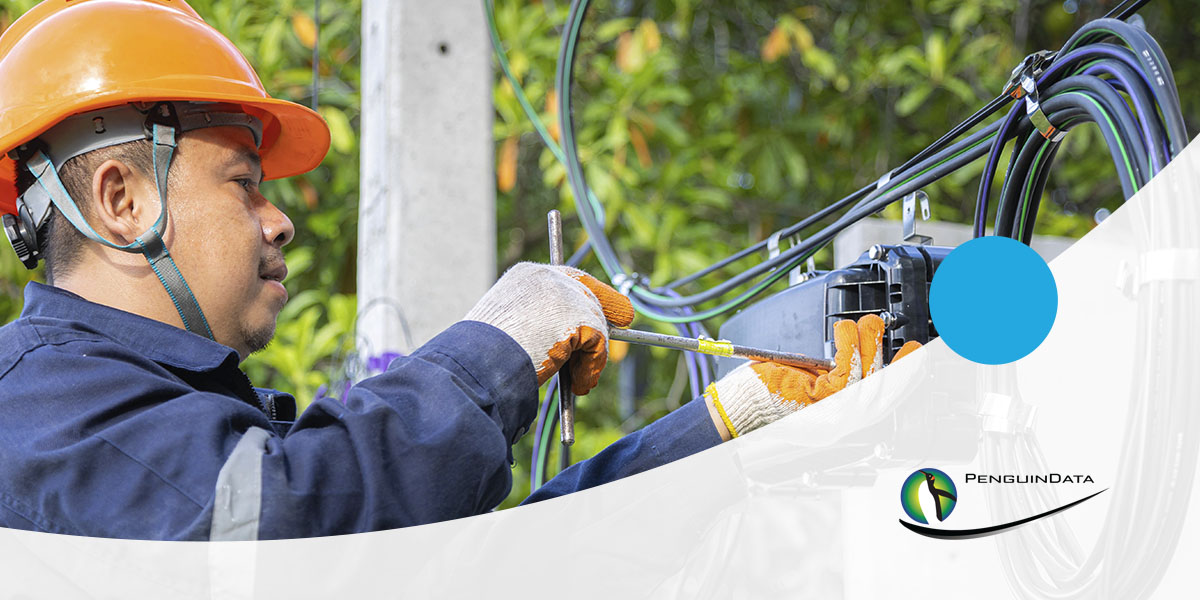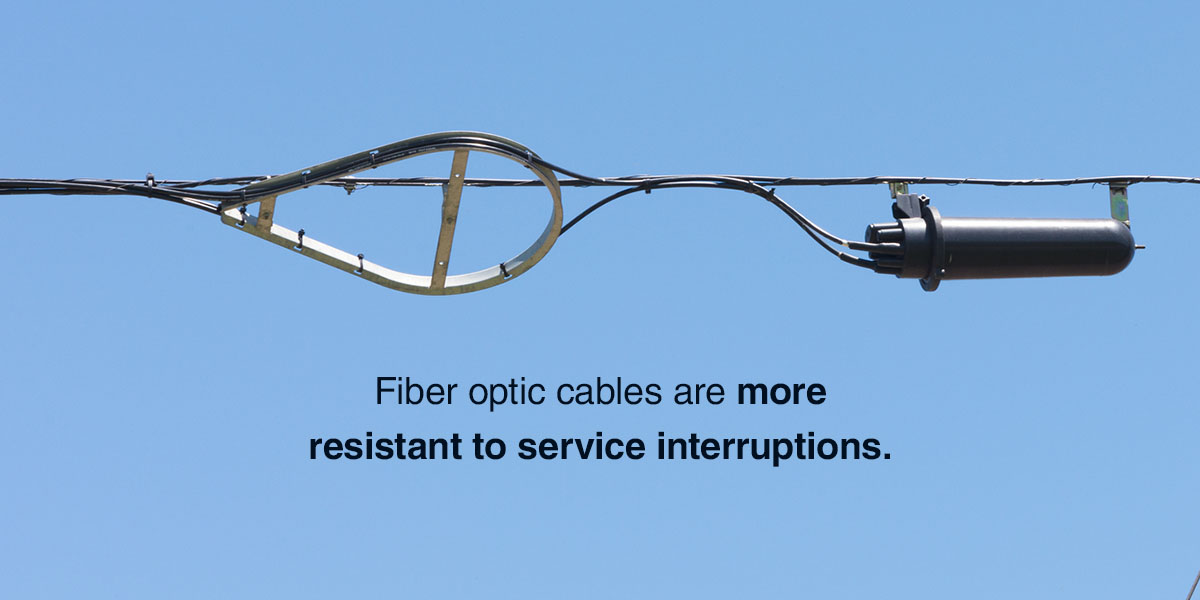
Table of Contents
- Rise of Fiber Optic Technology→
- Benefits of Fiber Optic Networks & Technology→
- Fiber Optic Network Construction→
- Importance of Having a WFM System for Fiber Optic Construction→
- PenguinData’s Fiber Optic Workforce Management Software→
When it comes to municipal fiber networks or fiber optic installation on a construction site, you and your team are responsible for many critical tasks at once. As automation and speed continue to heavily impact the fiber optics industry, it’s crucial for your company to take advantage of enhanced connectivity and efficiency through software.
Whether you want to better serve customers, improve compliance or stick to your budget, fiber construction software can help you accomplish these goals and keep your project on schedule. While the process of installing fiber optic cables can be complicated, getting real-time updates on reports, crew and materials shouldn’t be.
The Rise of Fiber Optic Technology
Fiber optic networks consist of cables that house bundles of optical fibers that transmit data from one location to another. Using pulses of visible or infrared light, these optical fibers carry information, such as internet, telephone and television signals. These networks make up most of the internet’s backbone, spanning thousands of miles to provide people with fast, reliable internet.
The structure of fiber optic cables enables light to travel along the core without dispersing or bouncing off. The extremely thin, long strands of fiber optics act as a transmission medium — or pipe — that carries signals over long distances at high speeds.
The three main types of fiber optic networks include:
- Fiber to the home (FTTH): A connection from a telecom operator’s central office to consumer homes. Also described as a fiber to the premises (FTTP), a high-speed connection from a central location to an individual building.
- Fiber to the cabinet (FTTC): A connection from the central office to street cabinets. Then, copper cables are used to connect from the cabinet to the home.
- Fiber to the tower (FTTT): A connection from a primary telecom network to a cellular network tower.
Fiber optic speed has played a significant role in breaking down the digital divide, which refers to the unequal access among regions and demographics that have access to modern digital technology. For instance, those in rural areas are four times more likely to lack access to broadband internet than those in urban areas. This divide impacts individuals’ access to online education, job opportunities and telehealth services.
Fiber optic technology, including FTTH converters, is helping to bridge the gap by providing high-speed internet connectivity, reduced latency and improved reliability to underserved areas. Though fewer than 45% of Americans have access to fiber internet connections, the technology behind fiber-optic internet and utility will continue to expand thanks to the $65 billion in government support for expanding broadband internet access across the U.S.
By 2032, the global fiber optics market is expected to reach nearly $17 billion as fiber optics cable and sensors are becoming more widely used for utility, oil and gas, railway, telecom, medical, industrial and military industries. Because fiber optic technology has the ability to retain high amounts of data integrity even at long distances, many industries can access and transfer information faster than ever before.
Benefits of Fiber Optic Networks and Technology
Fiber optic infrastructure enables a multitude of benefits to businesses and communities alike:

- Lightning-fast data transfer: Fiber optic connections can deliver very high speeds, reaching up to 10 gigabits per second without buffering or lagging. This enables businesses to depend on communication tools without delay to enhance customer satisfaction and productivity.
- Improved communications: With a single platform for communication systems — such as video, voice and data services — fiber optic networks are an ideal solution for streamlined international communication, enabling global networks.
- Enhanced reliability: Fiber optic cables are also less susceptible to electromagnetic interference than traditional cables like copper, providing a more stable connection. Fiber optic cables are more resistant to service interruptions.
- Data security: Improved immunity against electromagnetic signals also means fiber optic cables are less vulnerable to data breaches and unauthorized access. This enhanced security measure is critical for protecting sensitive business information.
- Cloud computing: Businesses that rely on cloud-based applications, such as PenguinData’s construction workforce management software, can depend on fiber optic networks for symmetrical uploading and downloading speeds. Companies can access cloud platforms smoother and faster to leverage the advantages of cloud computing and scalability.
- Increased bandwidth: Fiber optics technology has a larger capacity for handling more devices and connectivity without losing speed. As internet usage grows, fiber optics offer the potential to scale for a smoother and uninterrupted experience.
- Societal advantages: Fiber-optic infrastructure can propel businesses and communities forward by facilitating fast, seamless two-way data transfer. Improved voice, video, data, internet and cable connections can help underserved regions thrive, contributing to economic growth and telecommunications services. Fiber optics can enable remote learning, reduced lags and buffering, video conferencing and seamless collaboration.
Fiber Optic Network Construction
Large-scale fiber optic cable installation projects can take a significant amount of planning, assigning crews and ordering materials. Here are some construction techniques that support your fiber optic network building process.
- Underground cables: This type of construction process requires heavy construction equipment to facilitate trench digging. The depth of the trenches for the fiber optic cables depends on the climate, as they are generally dug deeper the colder an environment gets. If infrastructure is already established, microtrenching can be used to avoid disrupting power lines or existing fibers.
- Aerial fiber links: In uneven or rocky terrain, an above-ground fiber optic network can be constructed using poles or towers. Overlashing is a practical solution that consists of attaching the fiber optic cables to existing power cables to reduce new construction, labor and materials.
- Conduit placement: Installing conduits can protect fiber optic cables from sharp edges and prevent them from hanging freely where they could be damaged. Plastic or steel conduits can protect cables from breaking where they have to bend, preventing connection interruptions. Carefully planning your route with Map Overlay Technology from PenguinData will help ensure your cables are not vulnerable to unnecessary hazards.
Before any fiber optic installation project, it’s critical to review relevant regulations on local and national levels. Adhering to safety guidelines is also essential to ensure compliance and the well-being of your crew. With a construction project management solution, you can access the details you need to keep your project on track.
The Importance of Having a WFM System for Fiber Optic Construction
Constructing a fiber network can often result in high costs, particularly for large-scale projects. Several elements of fiber optic construction can drive cost estimates, including:
- Material prices
- Required level of technical expertise
- Distances traversed
- Physical labor, including trench digging, splicing and connecting
- Complexity of terrain
- Underground or aerial construction
- Rework time and labor
Any of these factors can contribute to unplanned expenses and cause your team to fall behind schedule. With a workforce management system (WFM) for fiber optic construction, you can reduce rework by proactively addressing potential issues and effectively tracking labor, budget and materials. A WFM system absorbs a hefty portion of tasks, streamlining processes and automating work to support operators. Improved visibility into projects also enables cost-saving opportunities by managing expenses and facilitating a digital operation.
Fiber systems can further benefit from a WFM system by minimizing network downtime in the event of fiber cuts. Adverse weather conditions and construction work can lead to network outages and fiber infrastructure damage. Fiber cuts can be costly and impact your company’s ability to deliver reliable internet service. WFM systems can streamline troubleshooting by pinpointing problems with seamless communication and organization.
Contact PenguinData for a Free Demo
Having a project derail due to inefficient paper invoicing and poor visibility can be incredibly frustrating. If you’re interested in learning how to manage your fiber optic installation projects more effectively, look no further than PenguinData. Our Construction Project Management Software transforms the way construction businesses schedule and track large-scale jobs.
PenguinData reinvents the way you view your projects by providing reliable key insights and details that are instantly available for you to manage from any location. Dedicated construction workforce management software from PenguinData enables your company to evolve with reduced overhead, better documentation, simplified budgeting and improved communication. To learn more about how our solutions can help improve fiber optic network construction projects, schedule a free demo today.

